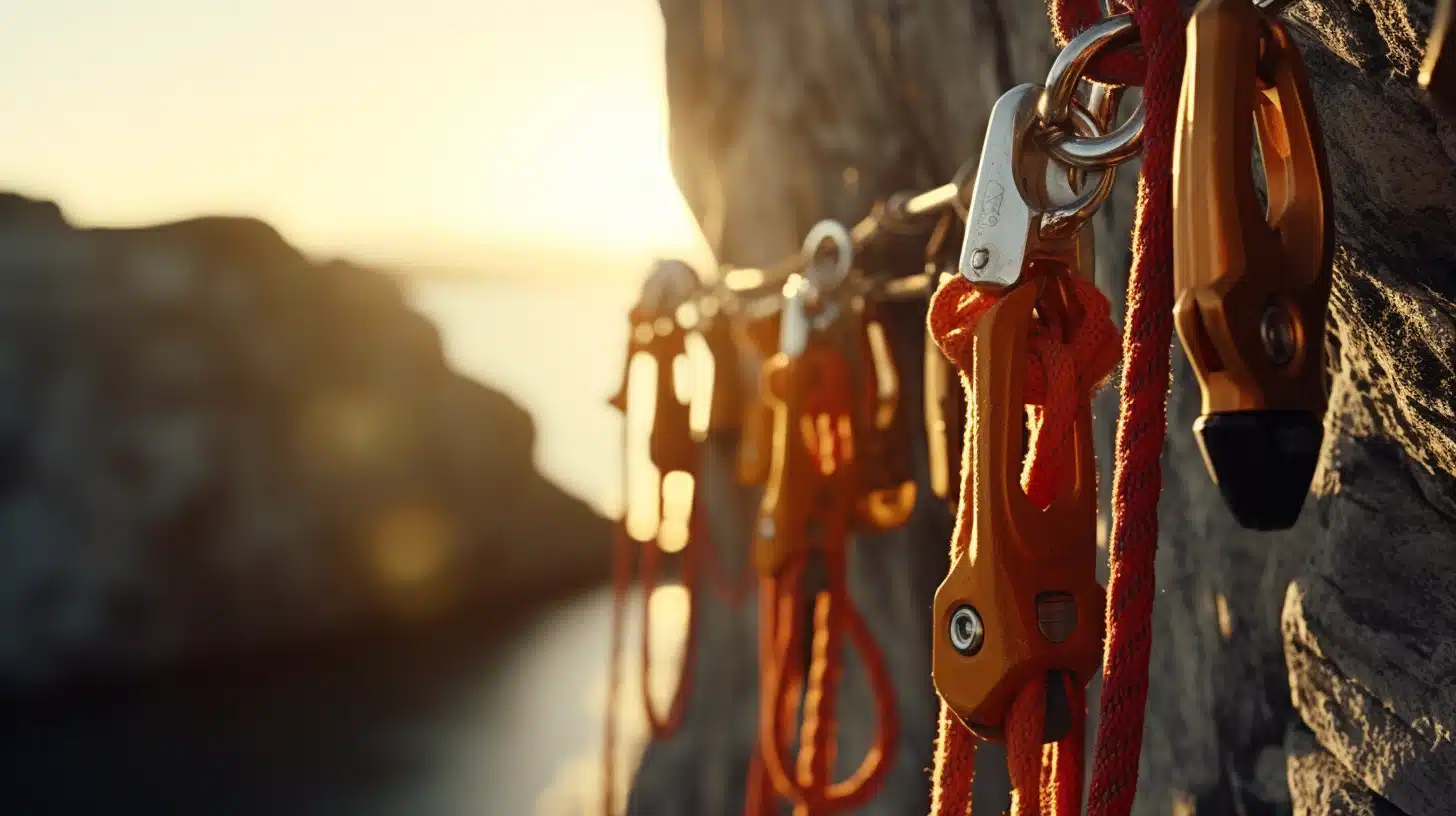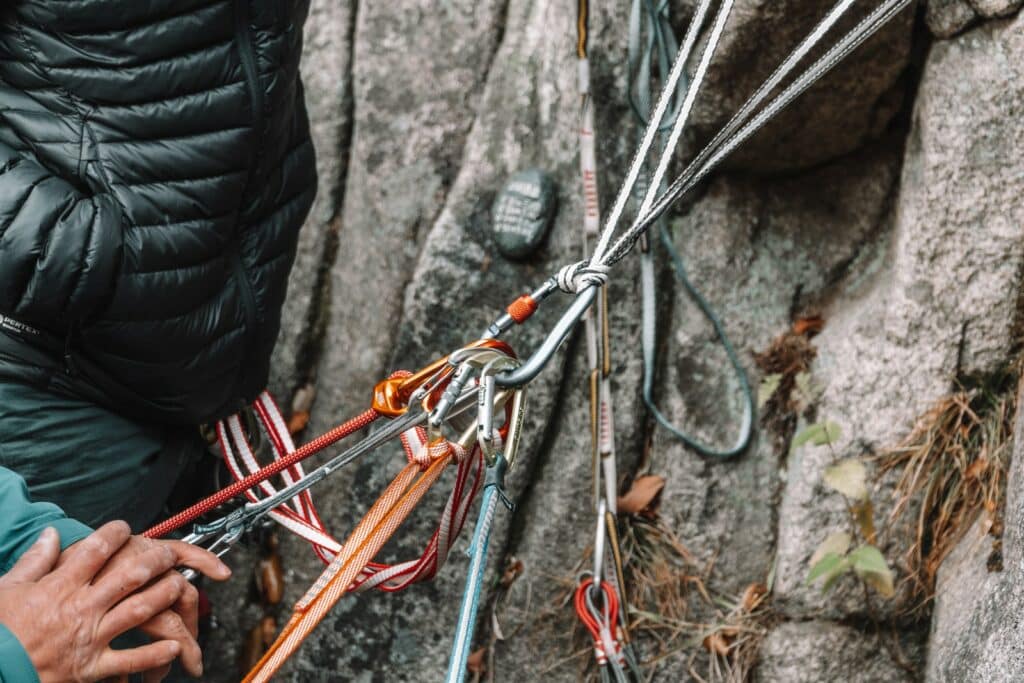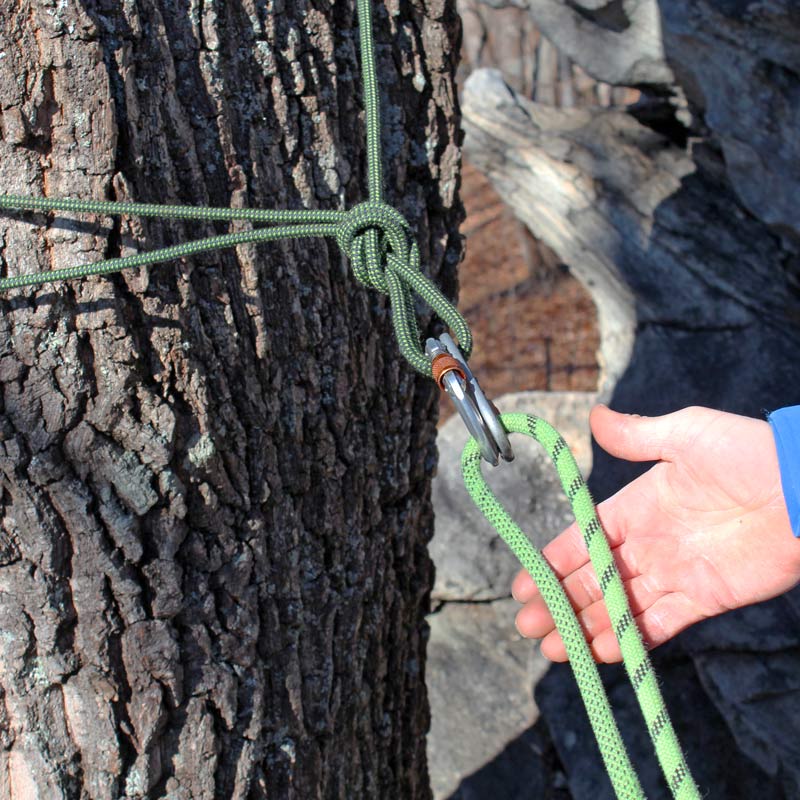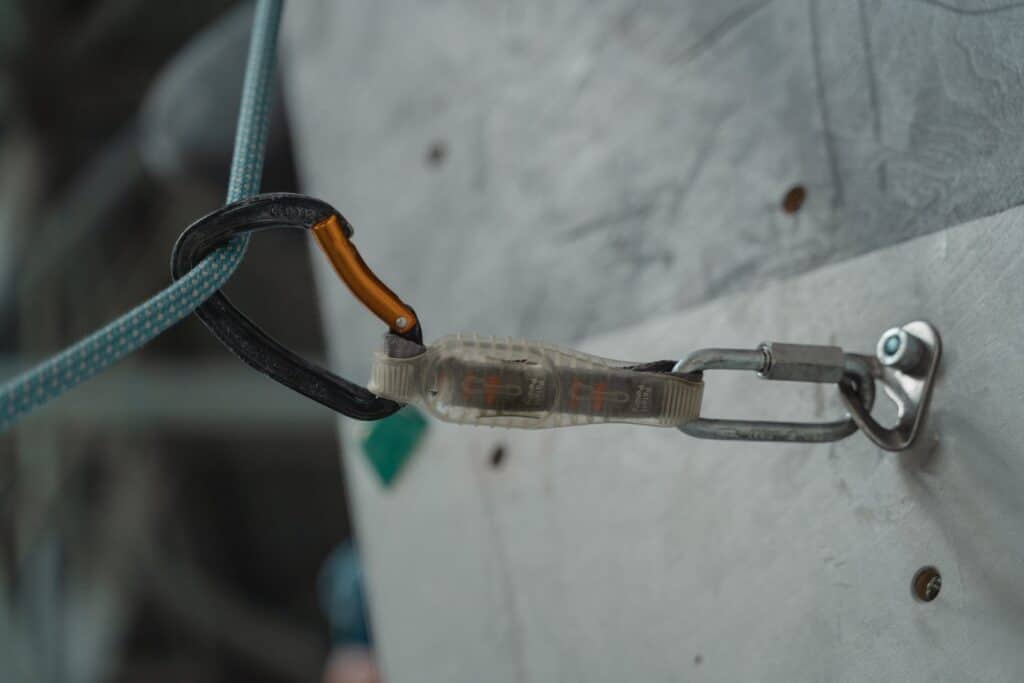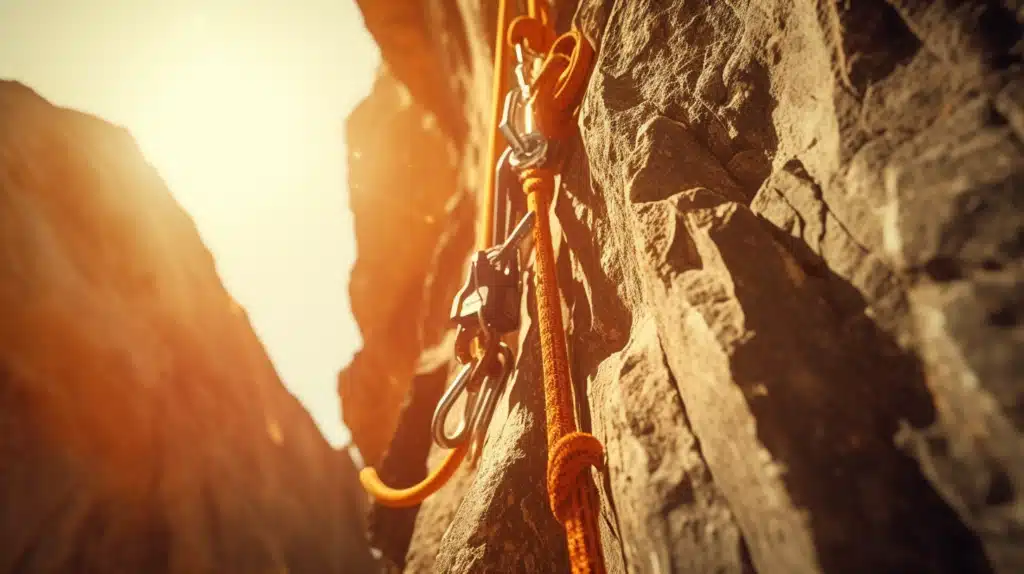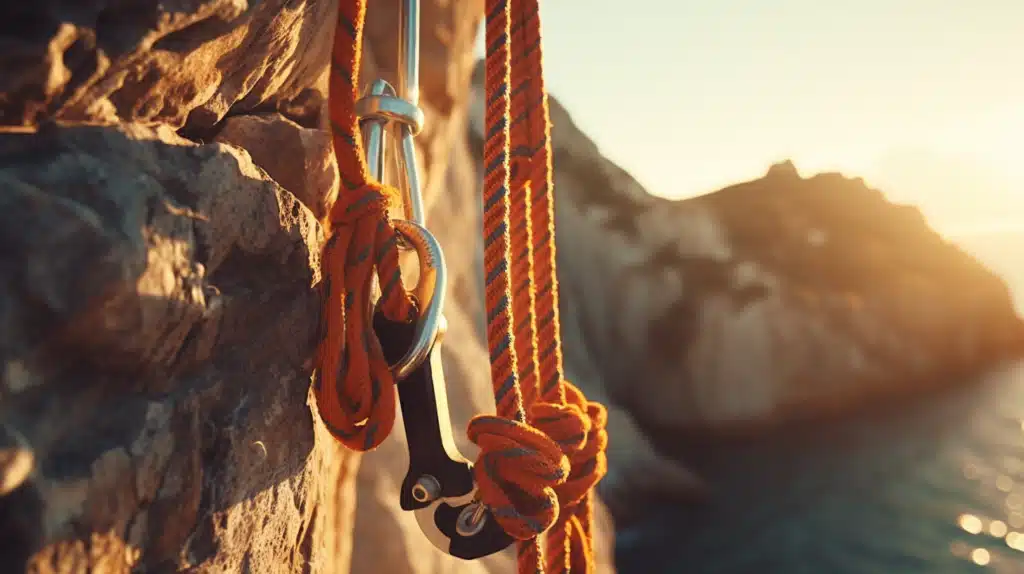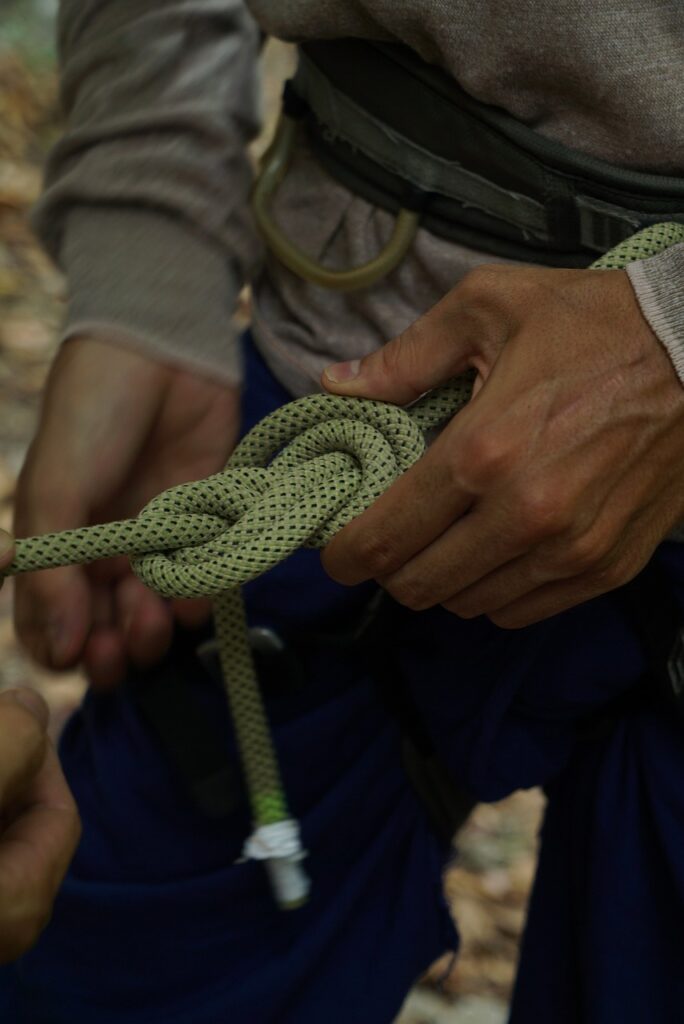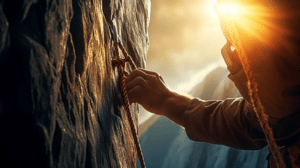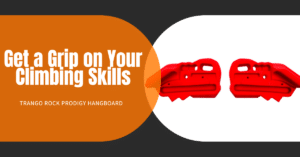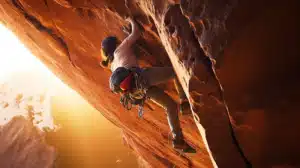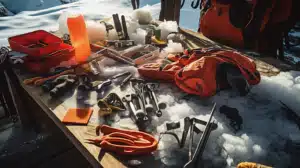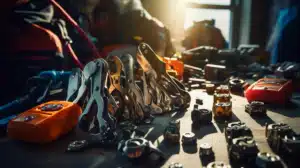Table of Contents
ToggleTrad Climbing Anchors: The Basics
When it comes to trad climbing, understanding how to build secure and reliable anchors is of paramount importance. Trad climbing involves the use of removable gear, such as nuts, cams, and hexes, to create anchors and protect the climb. Anchors are constructed by placing gear in cracks or other natural features in the rock. In this section, we will explore the basics of trad climbing anchors, including their purpose and the importance of secure placements.
Understanding Trad Climbing Anchors
Trad climbing anchors are built to provide a secure and strong point of protection for the climber in the event of a fall or other unexpected loads. These anchors should be made with at least two (preferably three) good pieces of gear, which can be close together or far apart on the climb. The technique and skills for building anchors need to be adapted for each unique situation, considering factors such as available gear, spacing, number of ropes, and whether the climb is single or multi-pitch (VDiff Climbing).
To create a trad climbing anchor, climbers carefully select and place gear in cracks or other features in the rock. The gear placements need to be equalized together to form a central point, where the climber attaches themselves and belays from. Equalizing the gear placements spreads the load across multiple pieces, ensuring a balanced distribution of forces (VDiff Climbing). This technique helps to minimize the chances of a single gear piece failing and provides redundancy in case of gear failure.
Importance of Secure Anchors
Building a solid trad climbing anchor is crucial for the safety of both the climber and the belayer. The strength and reliability of a trad climbing anchor depend on proper placement and equalized distribution of forces across multiple pieces of gear. An anchor should be worth at least 6 points, and gaining experience is crucial in learning how to determine the strength of an anchor (VDiff Climbing). It is essential to inspect the gear placements carefully, checking for any signs of damage or wear, such as frayed slings or compromised gear.
In trad climbing, if you can’t find enough gear for a secure anchor, it is necessary to find another location or climb higher or down-climb to find a suitable place. Building a trad climbing anchor requires knowledge of different types of gear and their placement techniques, as well as an understanding of the rock type and its features. Different rock types may require specific considerations, such as using specialized gear or avoiding certain types of placements.
By understanding the basics of trad climbing anchors and the importance of secure placements, climbers can build strong and reliable anchors that provide the necessary protection during their climbs. Remember, building a solid trad climbing anchor requires practice, experience, and continual learning. Always prioritize safety and seek guidance from experienced climbers or professionals to enhance your anchor building skills. For more information on trad climbing techniques and tips, check out our article on trad climbing techniques.
Gear Placement Techniques for Trad Climbing Anchors
When it comes to building reliable trad climbing anchors, selecting and placing the right gear is of utmost importance. The strength and reliability of your anchor system depend on the quality and proper placement of the gear. In this section, we will explore the techniques for selecting and placing gear, as well as the importance of equalizing gear placements.
Selecting and Placing Gear
Trad climbing anchors should be made with at least two, preferably three, good pieces of gear. The types of gear commonly used for building trad climbing anchors include passive protection, such as nuts and hexes, as well as active protection, such as cams and spring-loaded camming devices (SLCDs) (REI).
When selecting gear for your anchor, consider the specific climbing situation and rock type. Different types of gear are more suitable for certain rock features and crack sizes. It’s important to have a variety of sizes and types of gear in your rack to accommodate different placements.
To place the gear, carefully assess the rock and identify solid placements where the gear will be secure. Look for cracks, pockets, or other features that will provide reliable support. Proper placement techniques vary depending on the type of gear being used, so it’s essential to familiarize yourself with the specific guidelines for each piece. Ensure that the gear is seated firmly and won’t shift under weight.
Equalizing Gear Placements
Once the gear is placed, it’s crucial to equalize the gear placements to create a central point where you can attach yourself and belay from. Equalization helps distribute the load evenly across the gear and minimizes the force on each individual piece, increasing the overall strength of the anchor (Climbing).
To equalize gear placements, you can use slings and webbing. Start by attaching a sling or a length of webbing to each piece of gear using appropriate carabiners. Then, gather the strands of slings or webbing and bring them together at a central point. Adjust the lengths of the slings or webbing to ensure equal tension on each piece of gear.
It’s important to note that equalization is not always achieved by simply pulling on the slings or webbing. The direction and angle of the gear placements, as well as the position of the anchor point, can affect the equalization process. It’s essential to learn proper equalization techniques and practice them to ensure a secure and balanced anchor.
By mastering the techniques of selecting and placing gear and equalizing gear placements, you can build reliable trad climbing anchors that provide a safe and strong foundation for your climbs. Remember to always educate yourself, practice under the guidance of experienced climbers, and continually develop your skills in anchor building.
Building Reliable Trad Climbing Anchors
When it comes to trad climbing, building reliable anchors is of utmost importance to ensure the safety and success of the climb. There are several factors to consider when constructing trad climbing anchors, and implementing redundancy and backup systems is crucial.
Factors to Consider in Anchor Building
Constructing a solid trad climbing anchor requires careful consideration of various factors. Firstly, it is essential to select good gear placements. Ideally, anchors should be made with at least two (preferably three) reliable pieces of gear, which can be close together or far apart on the climb (VDiff Climbing). The technique and skills for building anchors need to be adapted for each unique situation, considering factors such as available gear, spacing, number of ropes, and whether the climb is single or multi-pitch. Properly equalizing and balancing the components of the anchor system is important to minimize the force and stress on each individual piece of gear and increase the overall strength of the anchor (Climbing).
Secondly, anchor placement should take into account the rock quality and features to ensure the integrity of the anchor. The strength and reliability of the anchor depend on proper placements and equalized distribution of forces across multiple pieces of gear. Different types of gear, such as cams, nuts, and hexes, may be required based on the rock type and its features. It’s important to have a good understanding of the gear and its placement techniques to build a solid trad climbing anchor (hardclimbs.info).
Redundancy and Backup Systems
In trad climbing anchor building, redundancy is key. A reliable anchor should have multiple points of attachment, also known as redundancy or backup systems, to distribute the load and provide backup in case one point fails (REI). This ensures that even if one piece of gear were to fail, there are other points of attachment to support the load.
To achieve redundancy, it’s crucial to use multiple reliable pieces of gear and connect them together to form a central point where the climber attaches themselves and belays from. Building redundancy into the anchor system increases safety and mitigates the risk of gear failure.
Inspecting and evaluating the strength of gear placements is vital to ensure the reliability of the anchor. Regular inspection and maintenance of the anchor is necessary to identify any signs of wear, damage, or deterioration. This includes checking the integrity of the gear placements, ropes, slings, and carabiners used in the anchor system.
By considering various factors in anchor building and incorporating redundancy and backup systems, climbers can create reliable trad climbing anchors that provide the necessary safety and security during the climb. It’s important to continually learn and refine anchor building skills to ensure the highest level of safety and enjoyment in trad climbing. For more information on trad climbing techniques and safety, check out our article on trad climbing tips.
Inspecting and Testing Trad Climbing Anchors
As a trad climber, it is crucial to regularly inspect and test your climbing anchors to ensure their reliability and safety. This involves conducting regular inspections and evaluating the strength of gear placements.
Regular Inspection and Maintenance
Regular inspection and maintenance of your trad climbing anchors are essential to ensure their integrity and reliability. It is important to thoroughly check for any signs of wear, damage, or loose components. Inspect all the gear placements, including cams, nuts, and other anchor components, to ensure they are in good condition and properly seated.
During your inspection, pay close attention to the quality of the rock and its ability to hold the gear. Check for any loose or crumbling sections that may compromise the strength of the anchor. If you notice any damaged or worn-out gear, it is crucial to replace it immediately to maintain the strength of the anchor system.
By performing regular inspections, you can identify any potential issues or weaknesses in your anchor system and address them before they become a safety concern. Remember, the most common mistake in anchor building is using poor-quality or worn-out gear, so it’s essential to keep your gear in top condition.
Evaluating the Strength of Gear Placements
In addition to regular inspections, evaluating the strength of your gear placements is a crucial part of anchor building. This involves assessing the quality and reliability of each gear placement in your anchor system.
Inspect each gear placement carefully, ensuring that cams and nuts are properly seated and secure. Consider the type of rock you are climbing on and its ability to hold the gear. Evaluate the strength of each gear placement by testing it with gentle pulls and assessing how well it holds. This will give you an indication of the reliability and integrity of the anchor.
When evaluating gear placements, consider the direction of the forces that will be applied to the anchor. Ensure that the placements are oriented to handle these forces efficiently and distribute the load evenly. This is especially important when equalizing gear placements to create a strong and balanced anchor system.
By regularly inspecting and testing your gear placements, you can have confidence in the strength and reliability of your trad climbing anchors. Remember to seek proper education and practice in anchor building techniques to enhance your skills in creating solid and secure anchors in various climbing situations (Denver Climbing Company). Safety should always be the top priority in trad climbing, and thorough inspection and testing are key elements of a responsible climbing practice.
Anchor Building Techniques for Different Rock Types
When it comes to trad climbing, building a solid anchor is essential for the safety and security of the climbing party. However, the quality and features of the rock can greatly influence the strength and reliability of the anchor. Therefore, it’s important to understand the relationship between rock types and anchor integrity.
Rock Quality and Anchor Integrity
Different types of rock have varying strengths and characteristics, which can impact the effectiveness of an anchor. Before building an anchor, it’s crucial to assess the quality of the rock. Clean, solid, and uniform rock provides better opportunities for secure anchor placements. On the other hand, loose or fractured rock may require alternative anchor-building techniques.
Types of Gear for Different Situations
The choice of gear for anchor building depends on the rock type and its features. Here are some common gear options for different situations:
- Cams: Camming devices, such as cams or camalots, are effective for anchor placements on clean, solid, and uniform rock. These devices utilize spring-loaded cams that expand and grip the rock, providing a secure placement. Cams come in various sizes to accommodate different crack widths (trad climbing cams).
- Nuts: Nuts, also known as stoppers or chocks, are passive protection devices that are wedged into cracks. They are particularly useful for anchor building on rock with irregular features or smaller cracks. Nuts come in different sizes and shapes to fit a variety of crack types and provide reliable placements (trad climbing nuts).
- Hexes: Hexes are hexagonal-shaped passive protection devices that can be placed in cracks, offering versatility for anchor building. They are suitable for both clean and irregular rock types. Hexes provide multiple contact points within a crack, increasing stability and security (trad climbing hexes).
- Slings and Cordage: Slings and cordage are essential for extending anchor placements and equalizing gear. These materials allow for flexibility in constructing anchors and distributing loads evenly. Nylon or Dyneema slings, along with locking carabiners, are commonly used in anchor building (trad climbing slings).
When building an anchor, it’s crucial to consider the specific characteristics of the rock you are climbing on. Always choose gear and techniques that align with the rock type and quality. If you’re unsure about the suitability of a particular rock for anchor building, consult with experienced climbers or local climbing guides for guidance.
By understanding the relationship between rock types and anchor integrity, as well as the appropriate gear for different situations, you can enhance the safety and reliability of your trad climbing anchors. Remember to continuously expand your knowledge and skills in anchor building to ensure a secure and enjoyable climbing experience.
Anchor Configuration and Load Distribution
When it comes to building reliable trad climbing anchors, proper anchor configuration and load distribution are of paramount importance. By employing the right techniques, climbers can ensure that their anchors are strong, secure, and able to withstand the forces exerted during a climb.
Triangular Configurations for Even Load Distribution
One commonly used method for anchor configuration is the triangular setup, which helps to distribute the load more evenly among the pieces of protection. Two popular triangular configurations are the equilateral triangle and the equalized triangle. These configurations involve placing multiple pieces of gear in such a way that the anchor forms a triangle shape.
The equilateral triangle configuration involves placing three pieces of gear equally spaced apart, forming an equilateral triangle shape. This setup helps to evenly distribute the load and prevent any single piece of protection from taking all the force. By distributing the load across multiple points, the equilateral triangle configuration enhances the overall strength and reliability of the anchor system.
Another triangular configuration is the equalized triangle. This setup involves placing three pieces of gear in a way that allows them to share the load equally. This is achieved by using slings or cordage to create equal lengths between the anchor points. The equalized triangle configuration ensures that each piece of protection contributes to the overall strength of the anchor, minimizing stress on any individual piece.
By utilizing these triangular configurations, climbers can ensure that the load is evenly distributed among the pieces of protection, enhancing the overall stability and strength of the anchor system. For more information on trad climbing anchor techniques and setups, check out our article on trad climbing anchors.
Reducing Shock Loading with Proper Extension
Shock loading, which occurs when a dynamic force is applied suddenly to an anchor, can significantly increase the stress on the anchor system. To mitigate the risk of shock loading, climbers can incorporate proper extension into their anchor setups.
Extension refers to creating a slight amount of slack or extension in the anchor system. This can be achieved by using slings or cordage to introduce a small amount of additional length between the anchor points and the main anchor point. By providing this extension, the force applied to the anchor system is gradually absorbed, reducing the potential for sudden and intense loading.
Proper extension helps to minimize the shock and impact forces on the anchor, distributing the load more evenly and reducing the stress on individual pieces of protection. This technique is particularly useful when climbing in areas with potential fall factors or dynamic movements. By reducing shock loading, climbers can enhance the overall strength and stability of their anchor systems.
It’s important to note that while extension is beneficial for reducing shock loading, excessive extension can introduce unwanted rope drag or reduce the efficiency of the anchor system. Finding the appropriate balance between extension and efficiency is key. For more tips on anchor building and trad climbing techniques, visit our article on trad climbing tips.
By employing triangular configurations and incorporating proper extension, climbers can ensure that their trad climbing anchors are built for optimal load distribution and strength. These techniques, combined with other factors like redundancy and backup systems, contribute to creating reliable and secure anchor systems, providing climbers with the confidence and safety needed for a successful trad climbing experience.
Learning and Practicing Anchor Building Skills
As a climber, learning and practicing proper anchor building skills is essential for ensuring your safety and the safety of your climbing partners. Building reliable anchors requires knowledge, experience, and continual skill development. Let’s explore the importance of education and guidance in anchor building, as well as the need for ongoing skill development.
Importance of Education and Guidance
When it comes to anchor building, proper education and guidance are crucial. It is highly recommended to learn anchor building techniques under the supervision of an experienced climber or a certified climbing instructor. They can provide valuable insights, demonstrate correct techniques, and offer personalized feedback to help you develop a solid foundation in anchor building.
Reputable climbing organizations and schools often offer courses or workshops focused on anchor building skills. These educational programs cover topics such as gear placement, equalization techniques, and anchor integrity. By participating in these courses, you can gain a comprehensive understanding of anchor building principles and best practices.
Additionally, seeking guidance from seasoned climbers can provide you with valuable real-world insights and tips. They can share their experiences, explain common mistakes to avoid, and offer guidance on adapting anchor building techniques to different climbing situations. Taking advantage of the knowledge and expertise of experienced climbers can significantly enhance your anchor building skills.
Continual Skill Development in Anchor Building
Anchor building is a skill that requires ongoing development and practice. As you gain experience and become more proficient, it is important to continually expand your knowledge and refine your techniques. This can be achieved through a variety of methods:
- Stay updated: Keep yourself informed about the latest developments in anchor building techniques and equipment. Stay up to date with industry publications, climbing forums, and reputable climbing websites that provide valuable insights and updates on anchor building practices.
- Practice regularly: Regular practice is essential for honing your anchor building skills. Set aside dedicated practice sessions at climbing gyms or outdoor climbing areas to reinforce your knowledge and build confidence in your abilities. Practicing in different environments and on different types of rock will help you adapt your skills to various scenarios.
- Seek feedback: Continually seek feedback from experienced climbers or instructors. They can provide constructive criticism, identify areas for improvement, and offer guidance on advanced techniques. Engage in discussions with fellow climbers to exchange insights and learn from their experiences.
- Expand your knowledge: Deepen your understanding of anchor building by studying reputable resources, such as climbing guidebooks, instructional videos, and online articles. These resources can provide valuable insights into advanced anchor building techniques, gear selection, and rock-specific considerations.
By investing time and effort into learning and practicing anchor building skills, you can build a strong foundation of knowledge and experience. Remember, safety should always be the top priority when building anchors. As you gain confidence in your abilities, you’ll be able to create reliable and secure anchor systems that will support you during your trad climbing adventures.
Next, let’s explore some of the common difficulties climbers may encounter when building trad climbing anchors, such as challenges with horizontal and flaring cracks, and the importance of choosing the right protection for different rock conditions.
Common Difficulties in Trad Climbing Anchor Building
Building solid and reliable anchors is crucial in trad climbing to ensure the safety of the climber. However, there are certain challenges that climbers may encounter when it comes to anchor building. Two common difficulties include dealing with horizontal and flaring cracks and selecting the right protection for different rock conditions.
Challenges of Horizontal and Flaring Cracks
Horizontal cracks and flaring cracks can present challenges when it comes to building secure trad climbing anchors. These types of cracks can make it difficult to find placements that are as secure as vertical or slightly angled cracks. Placing gear in horizontal or flaring cracks can create less secure placements, as the gear can easily become dislodged or pull out under load (Devil’s Lake Climbing Guides).
To overcome these challenges, climbers may need to employ alternative techniques and strategies. One option is to use specialized gear specifically designed for horizontal cracks, such as tricams or specialized camming devices. These types of gear can provide better stability and security in challenging crack orientations. Additionally, using passive protection like chocks and stoppers may offer more secure placements in these types of cracks.
Choosing the Right Protection for Different Rock Conditions
The type of rock you encounter during trad climbing can vary greatly, and it’s important to choose the right protection based on the specific rock conditions. When building anchors on clean, solid, and uniform rock, camming devices like cams and nuts can be effective for placements. These devices can provide secure and reliable protection in cracks with consistent dimensions. However, on loose or fractured rock, traditional protection like hexes or passive protection (chocks, stoppers, etc.) may be more secure.
It’s essential to assess the quality of the rock and understand its characteristics before selecting and placing gear for your anchor. Pay close attention to any signs of loose or unstable rock. In some cases, you may need to search for solid features, such as boulders, flakes, or horn-like protrusions, to create a secure anchor. Adaptability and flexibility in your gear selection will be key to building a reliable anchor system in different rock conditions.
By being aware of the challenges posed by horizontal and flaring cracks and understanding the importance of selecting the appropriate protection for different rock conditions, trad climbers can enhance their anchor building skills and create secure and reliable anchor systems. Remember to always prioritize safety and consult experienced climbers or guides for guidance and advice on specific climbing areas and techniques.

